7 Steps On How To Deal With 2-Year-Old Tantrums
Dealing with 2-year-old tantrums involves staying calm, addressing common triggers, such as hunger, tiredness, and loneliness, using distractions, and teaching emotional regulation. Staying calm is crucial for managing tantrums, as it models emotional regulation and helps determine whether the goal is to stop the tantrum immediately or reduce tantrums in the long term.
The importance of addressing 2-year-old tantrums lies in preventing problems in emotional development. Failure to manage temper tantrums contributes to personality problems, according to a 2014 study titled “Childhood maltreatment and personality disorders in the USA: Specificity of effects and the impact of gender,” conducted by Rachel Waxman et al. and published in Personality and Mental Health. Ignoring a 2-year-old’s tantrum is not a good idea because a young child needs guidance to develop emotional regulation, a learned skill children are not born with.
Two year old’s tantrums are often explosive emotional onset without warning. Many toddlers go from calm to screaming and flailing in an instant. Toddlers, unlike older children, tend to forget what upset them moments after a tantrum. Common triggers include being told “No,” lacking vocabulary to express themselves, and being misunderstood.
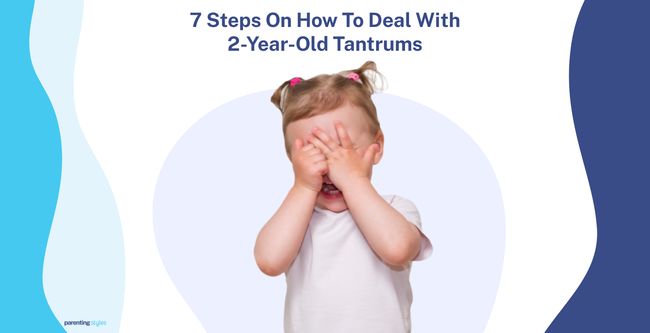
Offering choices or distractions helps reduce frustration by giving toddlers a sense of control and redirecting their focus to engaging activities. Co-regulation, where parents provide calm guidance, supports children in managing emotions, which eventually leads to self-regulation as children internalize these skills. Validating emotions and emotion-coaching, such as labeling feelings, helps toddlers feel understood and teaches them to express emotions through words instead of tantrums.
Guiding children during tantrums through comforting touches or verbal reassurances promotes emotional regulation and helps them manage distress constructively. Praising efforts to calm down and reflecting on coping strategies after a tantrum reinforce positive behaviors and teach children healthy ways to manage future emotional challenges. Addressing tantrums early is critical for emotional development, as unmanaged tantrums often contribute to maladjustment or behavioral issues later in life.
Two-year-olds commonly have tantrums due to their limited ability to express emotions or fulfill their desires independently, with triggers ranging from frustration to unmet needs. Severe tantrums marked by aggression, self-injury, or prolonged durations sometimes indicate emotional or developmental concerns, requiring professional evaluation. Preventing tantrums involves identifying triggers, teaching communication skills, maintaining routines, and modeling calm behavior, all of which foster better emotional regulation over time.
Tantrums less than five times a day are normal, lasting 1 to 15 minutes. Intense meltdowns last longer, particularly in children with Autism. Head-banging and throwing objects are common during anger. These behaviors must be addressed calmly and redirected toward healthier emotional expression. Two-year-olds are unlikely to have manipulative tantrums, as they lack the cognitive development for complex strategies like the theory of mind, which typically emerges around ages 3-5.
1. Stay Calm And Determine Your Goal
Staying calm is not reacting to a 2-year-old’s tantrum with anger or frustration, allowing you to determine your goal consciously. Two goals in dealing with 2-year-old tantrums are stopping this tantrum as fast as possible and stopping tantrums in the long run.
Ignoring the child tends to stop a tantrum quickly. Ignoring is recommended by the Centers for Disease Control and Prevention (CDC) based on the belief that children crave attention. Behaviorists believe that giving children attention during tantrums rewards the behavior and encourages more tantrums, an operant conditioning phenomenon discovered by psychologists B.F. Skinner. To ignore the child, make sure they are placed in a safe environment where they cannot hurt themselves or others. Reunite with the child when the child has stopped having tantrums.
Teaching the child emotional regulation tends to stop tantrums in the long run as you help the child develop skills to regulate themselves. To teach the child emotional regulation, remaining calm models how to react in difficult times. Parental calmness promotes the child’s emotional regulation, according to a 2021 study titled “Positive parenting, parenting stress, and child self-regulation patterns differ across maternal demographic risk,” conducted by Elizabeth M. Planalp et al. and published in Journal of Family Psychology.
2. Look For Common Triggers
Determined if the tantrum is caused by common triggers in young children, such as hunger, fatigue, or loneliness. Identifying what sets off a 2-year-old’s tantrum helps you plan and respond more effectively. Knowing the underlying cause of a tantrum helps you respond with empathy and understanding rather than frustration.
Observe the patterns of your child’s tantrums and avoid situations involving the triggers if possible.
Act quickly to resolve the issue if such a trigger is identified. For example, offer a nutritious snack if your child is hungry. Guide the kid towards a restful nap if the child is tired. Provide positive attention if loneliness is the cause. Following a daily routine and addressing basic needs such as food and sleep prevent tantrums from being triggered.
3. Give Choices Or Use Distractions
Offering simple options or redirecting attention to a different, engaging activity sometimes helps stop a 2-year-old’s temper tantrum.
2 year old toddlers crave independence. Offering choices empowers the child with a sense of control, helping reduce frustration and disappointment, which are common tantrum triggers. Having choices helps prevent power struggles.
Distractions that pique curiosity activate the brain, helping your child to think things through and calm down. Shifting the child’s focus to something more engaging diffuses escalating emotions.
These techniques foster cooperation and build early decision-making skills in a positive and nurturing way.
4. Co-Regulate To Help Self-Regulate
Co-regulation is a process of social regulation where one person takes a guiding role toward another. Co-regulation is sharing the self-regulatory processes and thinking of the more capable party.
Parents co-regulate by providing calm, supportive guidance to help the child regulate their emotions. The child gradually internalizes the regulation processes. Interpersonal regulation eventually becomes self-regulation, according to a 2016 study from Finland titled “How teachers co-regulate children’s emotions and behaviour in socio-emotionally challenging situations in day-care settings,” conducted by Kristiina Kurki et al. at University of Oulu and published in International Journal of Educational Research.
Parents’ reactions to children’s negative emotions provide children with information about experiencing and expressing emotions. Supportive responses help children reduce their negative emotions and understand emotions. Children learn to express and manage negative emotions when parents show sensitive, supportive interactions during emotional challenges, according to a 2021 study titled “The Terrible Twos: How Children Cope with frustration and tantrums and the effect of maternal and Paternal Behaviors,” conducted by Felix Deichmann and Lieselotte Ahnert, published in Infancy.
5. Validate And Emotion-Coach
Validating is letting your child know you understand their feelings and that negative emotions are normal. Emotion-coaching is teaching your child about emotions through acknowledging and labeling.
Emotion-coaching and validation help the child feel heard and supported, which are necessary as 2-year-old children struggle to understand themselves. Labeling emotions guides a child to express feelings through words instead of tantrums, according to a 2020 study titled “My child will actually say ‘I am upset’ … Before all they would do was scream”: Teaching parents emotion validation in a social care setting,” conducted by John A. Lambie et al. and published in Child: Care, Health and Development.
Validate your 2-year-old by reflecting their feelings. For example, “You seem very sad right now. Sadly, we can’t go outside because of the rain.” Another example is, “Your sister said something bad about you, and you are angry. You must be very hurt.” Use simple words in labeling emotions and explain the situation calmly. Speaking softly encourages the child to mirror calmness.
6. Help Them Regulate
Emotional regulation involves guiding a child in managing emotions and behaviors during distress. Emotional regulation involves recognizing feelings, calming down, and responding appropriately instead of impulsively.
Supporting emotional regulation during tantrums helps a child develop self-control and coping skills. Comforting touch is effective in emotion regulation as the child’s body learns to relax, according to a 2018 study titled “Affectionate touch and care: embodied intimacy, compassion and control in early childhood education,” conducted by Asta Cekaite and Disa Bergnehr in Sweden and published in European Early Childhood Education Research Journal. The child becomes more attentive and open to listening.
Hug your two-year-old, pat them on the back, hold your child’s hand, or stroke the hair to help them calm down.
7. Praise And Review To Teach Self-Regulation
Giving positive affirmations and reviewing healthy coping strategies reinforces self-regulation. The development of emotional self-regulation takes time, and praising motivates a child to keep practicing and improving. Reflections reinforce the connection between the effort and the desired outcome, fostering self-regulation skills.
Reflection and compliments toward self-regulation occur after the child has calmed down. For example, let the child know how proud you are by saying, “I’m proud of how you took a deep breath when you were upset. That’s a great way to calm down.”
Help your child understand what triggered the tantrum and brainstorm alternative ways to handle similar situations in the future. Try statements like, “Remember, take a deep breath every time you’re upset to help you feel better and stay calm,” reinforcing the self-regulation strategy.
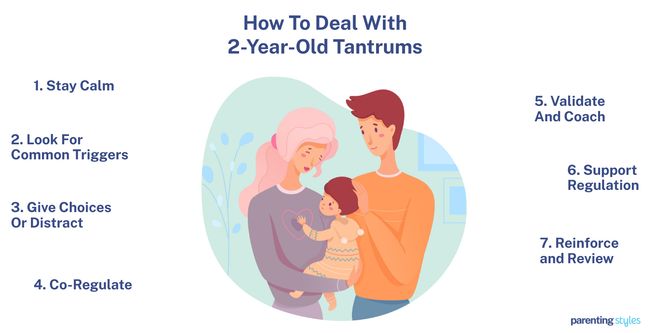
How Common Are Tantrums In A 2-Year-Old?
Tantrums are very common in 2-year-olds, with about 87% of children in 18 to 24 months experiencing them, according to a 2023 study titled “Developmental Pathways from Preschool Temper Tantrums to Later Psychopathology,” conducted by Caroline P Hoyniak et al. at Washington University in St. Louis and published in Development and psychopathology.
Two-year-olds are at the stage of developing independence, often wanting to do things on their own. The struggle between desire and ability to accomplish tasks leads to frustrations that escalate into anger. Limited verbal communication skills and an inability to self-regulate emotions hinder healthy expression, leaving crying, yelling, or throwing objects the only option. Tantrums are a normal part of children’s development.
What Is The Importance Of Addressing 2-Year-Old Tantrums?
The importance of addressing 2-year-old tantrums lies in preventing problems in emotional development. Failure to manage temper tantrums contributes to personality problems, according to a 2014 study titled “Childhood maltreatment and personality disorders in the USA: Specificity of effects and the impact of gender,” conducted by Rachel Waxman et al. and published in Personality and Mental Health.
Rejecting the child during tantrums increases the risk of maladjustment and the development of internalizing and externalizing problems, according to a 2011 study titled “Nature and Nurturing: Parenting in the Context of child temperament,” by Cara J. Kiff et al., published in Clinical Child and Family Psychology Review.
What To Do After A 2-Year-Old Tantrum?
After a 2-year-old tantrum, the caregiver acknowledges the child’s feelings, offer comfort and reassurance, and provide positive affirmations. 4 things “to do after a 2-year-old tantrum” are listed below.
- Acknowledge the Child’s Feelings: Use simple statements like, “You were really upset because you wanted that toy,” to show empathy without encouraging prolonged focus on the upset. Avoid dwelling on negative behaviors and emphasize the child’s feelings instead. Acknowledging the child’s feelings helps with developing emotional regulation skills, according to a 2016 study titled “The role of maternal emotional validation and invalidation on children’s emotional awareness,” conducted by John A. Lambie and Anja Lindberg, published in Merrill-Palmer Quarterly (1982-).
- Give Positive Reinforcement: Praise your child’s efforts to calm down. For example, say “I’m proud how you took some deep breaths”” or “”I’m glad you’re feeling calmer now.” Offering praise encourages self-regulation and reinforces positive behavior.
- Offer Comfort and Reassurance: Offer a hug or cuddle once your child calms down to show reassurance. Validating the child’s feelings teaches emotional acceptance and shows that you are a safe and trustworthy source of support during times of frustration.
- Move On to a New Activity: Engage in a new activity to shift the child’s focus. Read a book or go outside to let the child relax. Return to the previous activity if the tantrum happened before the action.
What Not To Do When Dealing 2-Year-Old Tantrums?
Things that you must not do when dealing with 2-year-old tantrums include yelling, taking outbursts personally, invalidating the child’s feelings, bribing, and imposing punishment. 6 things not to do when dealing with 2-year-old tantrums are listed below.
- Yelling: Yelling at a child during tantrums worsens emotional outbursts, increasing frustration and difficulty in emotional regulation. Screaming when the child is overwhelmed teaches the child to react with outbursts during emotional breakdowns, as noted in the 2012 study titled “Parental influences on children’s self-regulation of energy intake: insights from developmental literature on emotion regulation,” conducted by Leslie A. Frankel et al. and published in Journal of Obesity.
- Taking Outbursts Personally: Tantrums often stem from unmet needs, frustration, or an inability to communicate emotions, rather than a personal attack. Responding with impatience or frustration escalates the situation and ignores the underlying issue. Reacting emotionally hinders the opportunity to guide the child and prevents learning emotional regulation over time.
- Invalidating Child’s Feelings: Dismissing or minimizing a child’s emotions increases frustration and emotional distress. Do not make fun of the child’s feelings, as doing so invalidates their emotions.
- Bribing: Bribing during a tantrum teaches the child that disruptive behavior leads to rewards. Offering immediate incentives to stop crying or acting out provides short-term relief, but does not teach emotional regulation. Acknowledge the child’s feelings and offer guidance in expressing needs and emotions more effectively.
- Punishing the Child: Punitive punishment is linked to more frequent tantrums as harsh consequences increase feelings of frustration, confusion, or fear. Tantrums often stem from unmet needs or an inability to express emotions effectively, so punishment does not address the root cause.
- Giving In: Giving in during a goal-driven teaches the child that emotional outbursts are an effective way to achieve desired outcomes. Set clear, firm limits to show the child what is not acceptable. Help the child understand and name their feelings to encourage healthier expressions of emotions.
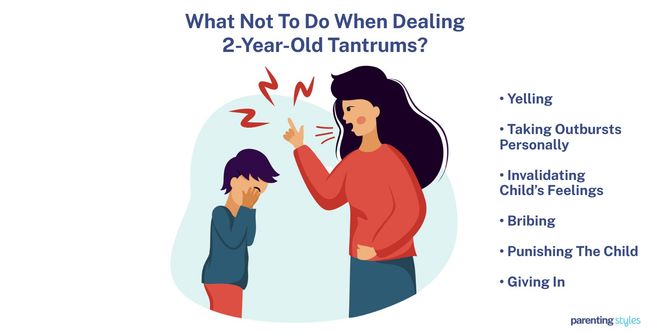
When Can You Ignore 2-Year-Old Tantrums?
You can ignore 2-year-old tantrums in a safe area when the emotional outburst seeks attention rather than stems from real distress. Ignoring helps reduce attention-seeking tantrums by removing reinforcement, according to a 2011 study titled “Assessment, management, and prevention of childhood temper tantrums,” by Elizabeth Daniels et al., published in American Academy of Nurse Practitioners.
However, most two-year-olds lack the developmental maturity to engage in attention-seeking tantrums. Ignoring the child risks neglecting essential guidance. Parents are recommended not to ignore 2-year-old tantrums.
A child in danger of harming themselves or others must never be ignored.
How To Prevent 2-Year-Old Tantrums?
Preventing 2-year-old tantrums involves identifying triggers, childproofing the home, and teaching how to communicate. 6 ways to discipline a 2-year-old positively and prevent tantrums are listed below.
- Identify Triggers: Observe what triggers the child’s tantrums and prepare steps to avoid or minimize the impact. For example, adjust your shopping schedule if tantrums happen often after the afternoon nap. Teaching the child strategies to handle emotions helps if the triggering situation is unavoidable. For example, take deep breaths and count to ten during overwhelming situations such as noisy or crowded places.
- Create a Daily Routine: Some tantrums are triggered by disruptions to the child’s expectations or routines. For example, a child anticipating screen time after finishing homework throws a tantrum if told that screen time is not allowed. Maintaining a consistent routine helps the child know what to expect.
- Childproof Home: Stopping a child from doing something dangerous often causes frustration. For example, a child becomes annoyed when a parent says “no” to getting into cupboards, leading to whining and stomping. Childproofing the home prevents the child from accessing restricted items and reduces the need to say ” no,” minimizing frustration.
- Teach How to Communicate: Frustrations build up when children are unable to communicate their wants or feelings. Teaching alternative ways to express emotions, desires, or discomfort decreases tantrums as children feel more understood. For example, encourage a child to express anger verbally when others take toys away, rather than through tantrums.
- Be a Good Model: Children imitate adult behaviors. Modeling calmness and patience during arguments teaches children positive ways of managing emotions. Refraining from using physical punishment teaches children that hitting is not permitted during times of frustration.
- Give Positive Attention: Children who do not receive positive attention resort to obtaining negative attention, according to the 2008 study titled “Temper tantrums: A normal part of growing up,” conducted by the American Academy of Pediatrics. Provide positive attention to the child by spending quality time, giving verbal praise, or utilizing a sticker chart as a reward system.
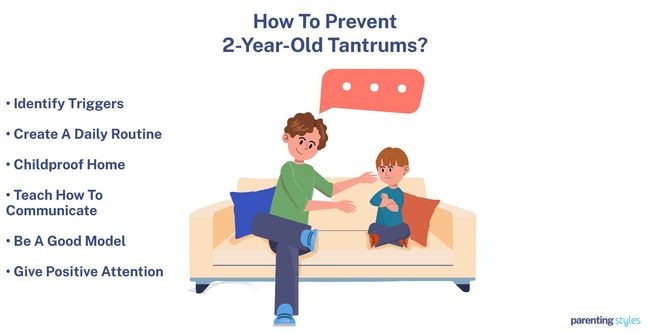
What Are The Signs Of 2-Year-Old Tantrums?
Signs of tantrums in a 2-year-old include crying, yelling, whining, hitting, throwing items, and breath-holding. 6 signs of tantrums in a 2-year-old are listed below.
- Crying or Screaming: Crying is the most common tantrum behavior, according to the 2003 study titled “Temper tantrums in young children: 1. Behavioral composition,” by Michael Potegal and Richard J. Davidson, published in Journal of Development and Behavioral Pediatrics. Loud, intense vocal expressions follows, observed in 40% of children in the study.
- Throwing Objects: Children often displace anger to other objects by throwing toys, household items, or other objects within reach. Others stomp or kick nearby objects.
- Falling to the Ground: Includes stiffening the body, flailing arms, and collapsing to the floor to show protest.
- Aggressive Movements: Include hitting, biting, pushing, or hurting another person.
- Changes in Breathing: Breath-holding spells occur when a child cries briefly, falls silent, and unintentionally stops breathing. Dysregulation in the autonomic nervous system triggers the spells, which also causes higher resting heart rate and diastolic blood pressure during tantrums.
- Refusal to Cooperate: Includes ignoring instructions, sitting down in protest, or attempting to run away.
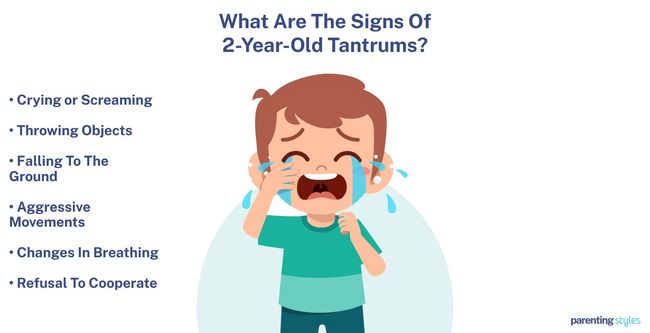
What Are Considered Severe Temper Tantrums In 2-Year-Olds?
Severe temper tantrums in 2-year-olds are characterized by more frequent, intense, and disruptive behaviors, according to a 2017 study titled “The impact of parenting on emotion regulation during childhood and adolescence,” conducted by Amanda S. Morris et al. and published in Child Development Perspectives.
More than five tantrums a day are considered severe. So do tantrums beyond 25 minutes and accompanied by self-injurious behaviors and aggression toward others.
There is no clear reason behind severe temper tantrums, but abnormal emotional outbursts are viewed as risk factors for developing behavioral disorders like conduct problems. Tantrums are sometimes early signs of children mental illness. Tantrums accompanied by sleep disorders, enuresis (bed-wetting), aggression, or extreme anxiety are signs of emotional problems. Consulting with psychologists or psychiatrists is recommended for further evaluation. Ensuring the child’s safety from aggression and self-injurious behaviors must be prioritized while waiting for professional guidance.
Why Do 2-Year-Olds Have Tantrums?
2-year-olds have tantrums because of the inability to express negative emotions effectively. Infants feel upset for various reasons but have limited language and emotional regulation skills to communicate and manage emotions, resulting in tantrum behaviors like crying, kicking, or throwing objects. Other causes include unfulfilled needs, attention-seeking behavior, wanting something, or avoiding tasks. 5 common causes of tantrums for 2-year-olds are listed below.
- Frustration: Toddlers are at the stage of forming independence but the inability to achieve their goals and desires often leads to frustration. Children lack the ability to process intense emotions, leaving anger outbursts the only option to express frustration. Toddlers with language deficits or autism spectrum disorder (ASD) experience tantrums more frequently because of communication difficulties, according to a 2023 study titled “Temper tantrums,” conducted by Laura L. Sisterhen and Paulette Ann W. Wy, published in StatPearls.
- Unfulfilled Needs: A child often throws a tantrum when basic needs, such as hunger, sleep, or comfort, are unmet, as noted in the 2019 study titled “Relations between toddler expressive language and temper tantrums in a community sample,” by Brittany L. Maning et al., published in Journal of Applied Developmental Psychology. The discomfort of being hungry or tired creates a feeling of distress, leading to emotional outbursts.
- Attention-Seeking Behavior: Toddlers ignored by parents resort to negative behaviors to seek attention. Tantrums are a strategy that 2-year-olds commonly use to ensure their needs are acknowledged.
- Wanting Something: Tantrums often occur when a toddler desires an object, activity, or outcome that is denied or delayed. The inability to manage disappointment or delay gratification leads to emotional outbursts.
- Avoiding Tasks: Toddlers use tantrums to resist or postpone compliance with demands. For example, challenging or undesirable tasks like cleaning up toys or leaving a play area often trigger outbursts.
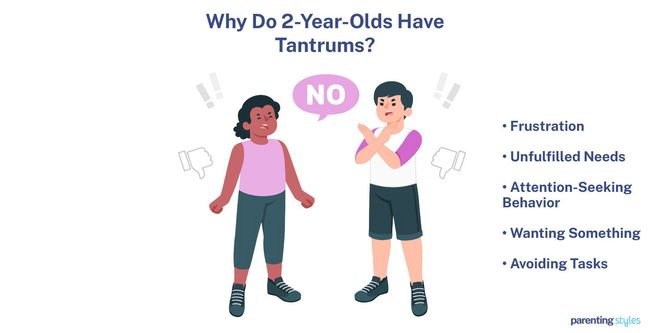
How Many Tantrums A Day Is Normal For A 2-Year-Old?
Tantrums less than 5 times a day are normal for a 2-year-old, according to a 2012 study titled “Assessment, management, and prevention of childhood temper tantrums,” conducted by Elizabeth Daniels et al. and published in American Academy of Nurse Practitioners.
The duration commonly lasts between 1 to 15 minutes and decreases as the child gets older, according to a 2010 study titled “A cross-sectional study of onset, cessation, frequency, and duration of children’s temper tantrums in a nonclinical sample,” by Karin Osterman and Kaj Björkqvist, published in the Psychological Reports.
Are Meltdowns Normal For A 2-Year-Old?
Yes, meltdowns are normal for a 2-year-old. Meltdowns are defined by some as intense responses to overwhelming situations, typically characterized by kicking, screaming, destruction of property, and withdrawal. Meltdowns are emotional tantrums. Meltdowns are longer and more intense than non-emotional tantrums, sometimes posing physical and emotional risks to the child and the caregiver, according to a 2017 study titled “It feels like something difficult is coming back to haunt me”: An exploration of ‘meltdowns’ associated with autistic spectrum disorder from a parental perspective,” conducted by Indiana Montaque et al. in the United Kingdom and published in Clinical Child Psychology.
A 2-year-old typically experiences a meltdown due to sensory overload and emotional triggers. Loud noises, crowded spaces, and frustration of needs overwhelm the child, resulting in disruptive behaviors. Meltdowns are common among children with autism spectrum disorder (ASD).
Why Does My 2-Year-Old Bang His Head When Angry?
A 2-year-old bangs his head when angry because of the inability to express the emotion in healthier ways. Toddlers have underdeveloped abilities to regulate emotions and lack language skills to express negative emotions verbally.
Other kids bang heads to produce stimulation or express boredom, tiredness, or frustration, according to a 2007 study titled “A preliminary description of the occurrence of proto-injurious behavior in typically developing children,” conducted by Henry S. Roane et al. and published in Journal of Early and Intensive Behavior Intervention.
Safety must be ensured when a 2-year-old hits his head when angry. Any sharp or hard objects nearby must be removed to prevent injuries. The response must remain neutral or calm to avoid increasing the child’s distress. Offering alternative ways to express anger helps develop self-regulation skills, minimizing potential head-hitting.
How To Stop A 2-Year-Old From Hitting And Throwing Things?
To stop a 2-year-old from hitting and throwing objects, provide a calm instruction to stop and explain why the behavior is unacceptable. Move the child to a safe space without objects to throw or people to hit to prevent escalating the outburst. Allow the child to spend a brief period in a controlled setting. A minute or two is enough to help a child regain composure, according to the American Academy of Pediatrics.
Discuss the incident after the child has calmed down to identify the underlying cause of the tantrum. Explore solutions together to address the child’s emotional needs and reduce the likelihood of repeated tantrums. Have patience, as toddlers often struggle to communicate, requiring a few tries to get to the bottom of the issue.
Are 2-Year-Olds Capable Of Manipulative Tantrums?
No, 2-year-olds are unlikely capable of manipulative tantrums.
Manipulative tantrums involve intentional outbursts aimed at achieving a desired outcome. For example, whining and stomping feet serve as tactics to pressure a parent into buying a toy. A 2-year-old kid is unlikely to have manipulative tantrums because a child must first understand that others have thoughts and beliefs different from their own, a skill known as theory of mind (ToM), according to a 2011 study titled “Theory of Mind and Neurodevelopmental Disorders of Childhood,” conducted by Baris Korkmaz and published in Neuropsychiatric Disorders and Pediatric Psychiatry. Theory of mind typically develops around 3-5 years old.
What Does Parentingstyles.Com Say About 2-Year-Old Tantrums?
To get more help with children temper tantrums, Parenting Styles suggests the ebook Calm The Tantrums written by Stanford-trained parenting specialist, Pamela Li.
What Readers Are Saying
Thank you for posting this article online! Very informative!